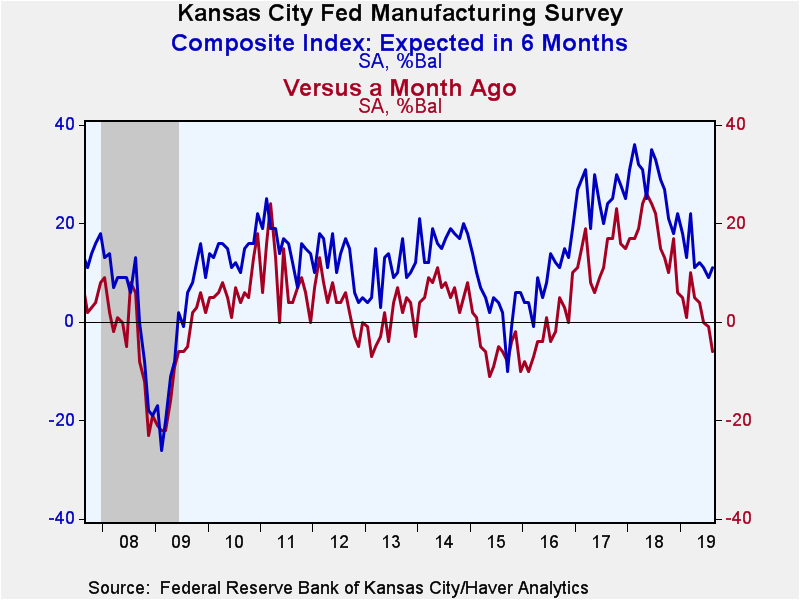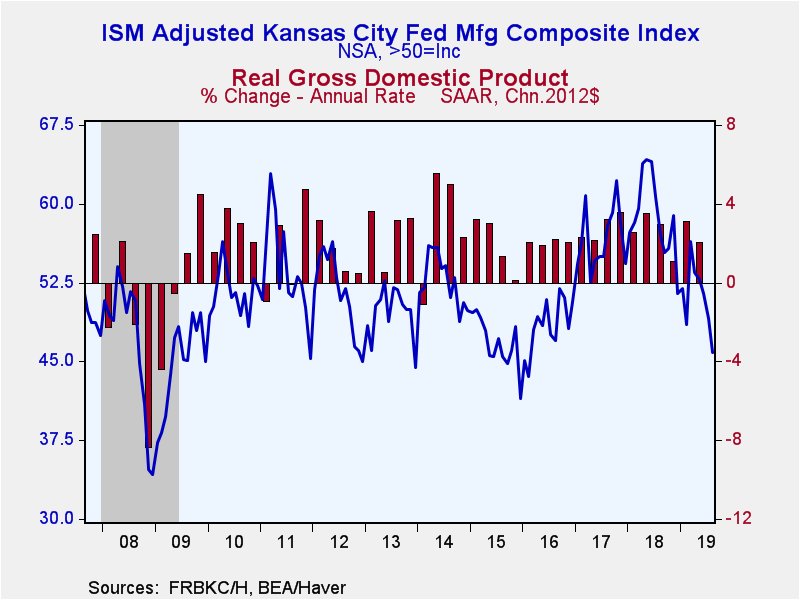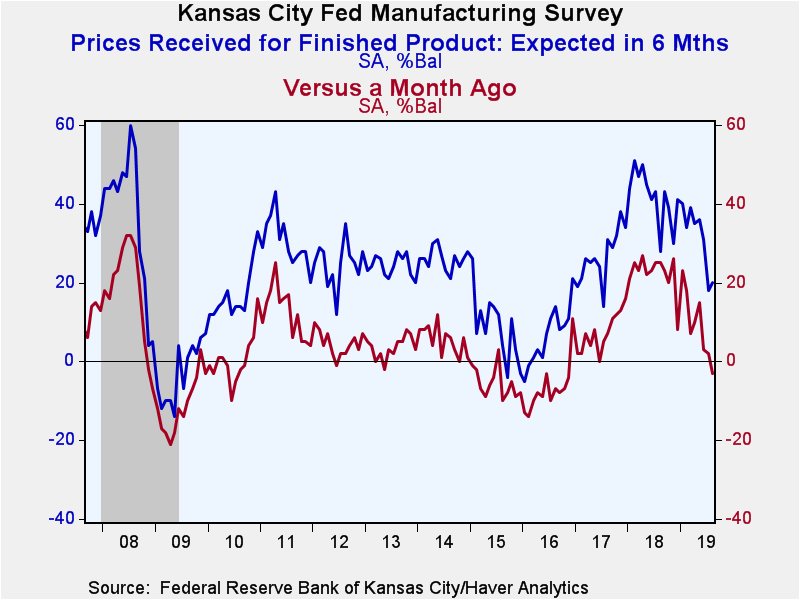 Global| Aug 23 2019
Global| Aug 23 2019Kansas City Federal Reserve Factory Sector Weakens Further
by:Tom Moeller
|in:Economy in Brief
Summary
The Federal Reserve Bank of Kansas City reported that its index of regional manufacturing business activity declined to -6 in August after falling to -1 in July. These negative figures suggest declining business activity overall and [...]
The Federal Reserve Bank of Kansas City reported that its index of regional manufacturing business activity declined to -6 in August after falling to -1 in July. These negative figures suggest declining business activity overall and were below the high of 26 reached last May.
The ISM-Adjusted index fell to 45.8 (NSA) this month from 49.1 in July. It remained below the high of 64.2 reached in May 2018. Since 2008, there has been a 54% correlation between this index and the q/q change in real GDP.
Deterioration in the factory survey was broad-based including the data for new orders, shipments and order backlogs. Production became less negative and the export order index improved to zero.
The employment reading remained below zero indicating a net decline in job levels. It was only the second negative reading since September 2016. A lessened 14% (NSA) of respondents reported increased hiring while a fairly steady 23% reported a decline in job levels. The employee workweek index rose modestly after falling below zero in July for the first time since November 2016.
The index of finished goods prices declined below zero, an indication of price deflation. It remained well below the highs reached early last year. Nine percent of respondents paid higher prices versus 29% twelve months earlier. Twelve percent paid less versus four percent one year ago. The raw materials prices index fell below zero and was down from 44 last August.
The overall expectations index improved to 11, but still was below the high of 36 in February 2018. Expected new orders, shipments, employment and production remained weak, sharply below earlier highs. The expected capital expenditure figure remained well below its high early last year.
The expected finished goods price index stabilized at 20. It was nearly the lowest level in two years and below the high of 51 reached in February 2018. The expected raw materials price figure declined to the lowest level in nearly three years and was well below the February 2018 high.
The diffusion indexes are calculated as the percentage of total respondents reporting increases minus the percentage reporting declines. The survey included 94 responses from plants in Colorado, Kansas, Nebraska, Oklahoma, Wyoming and northern New Mexico. Data for the Kansas City Fed Survey can be found in Haver's SURVEYS database.
Tracking U.S. GDP in Real Time from the Federal Reserve Bank of Kansas City is available here.
| Kansas City Federal Reserve Manufacturing Survey (SA) | Aug | July | June | Aug '18 | 2018 | 2017 | 2016 |
|---|---|---|---|---|---|---|---|
| Conditions Versus One Month Ago (% Balance) | -6 | -1 | 0 | 15 | 18 | 14 | -2 |
| ISM-Adjusted Composite Index (NSA) | 45.8 | 49.1 | 51.5 | 57.0 | 58.9 | 56.7 | 48.5 |
| New Orders Volume | -16 | -2 | 5 | 13 | 17 | 17 | -2 |
| Number of Employees | -7 | -6 | 5 | 15 | 17 | 15 | -6 |
| Production | -2 | -6 | -3 | 10 | 18 | 17 | 0 |
| Prices Received for Finished Product | -3 | 2 | 3 | 25 | 22 | 7 | -7 |
| Expected Conditions in Six Months | 11 | 9 | 11 | 29 | 28 | 26 | 9 |
| New Orders Volume | 11 | 17 | 16 | 37 | 35 | 35 | 19 |
| Number of Employees | 7 | 5 | 11 | 33 | 33 | 31 | 8 |
| Production | 23 | 23 | 22 | 42 | 40 | 40 | 20 |
| Prices Received for Finished Product | 20 | 18 | 31 | 28z | 42 | 27 | 7 |
Tom Moeller
AuthorMore in Author Profile »Prior to joining Haver Analytics in 2000, Mr. Moeller worked as the Economist at Chancellor Capital Management from 1985 to 1999. There, he developed comprehensive economic forecasts and interpreted economic data for equity and fixed income portfolio managers. Also at Chancellor, Mr. Moeller worked as an equity analyst and was responsible for researching and rating companies in the economically sensitive automobile and housing industries for investment in Chancellor’s equity portfolio. Prior to joining Chancellor, Mr. Moeller was an Economist at Citibank from 1979 to 1984. He also analyzed pricing behavior in the metals industry for the Council on Wage and Price Stability in Washington, D.C. In 1999, Mr. Moeller received the award for most accurate forecast from the Forecasters' Club of New York. From 1990 to 1992 he was President of the New York Association for Business Economists. Mr. Moeller earned an M.B.A. in Finance from Fordham University, where he graduated in 1987. He holds a Bachelor of Arts in Economics from George Washington University.










